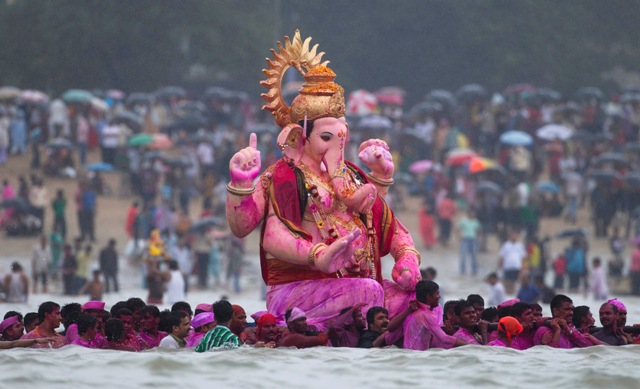
The lores about Lord Ganesha are numerous and varied. From his birth to his marriage and from his knowledge to his wit, each story is the stuff of legends. Here is a quick look at what led to the making of the deity we love to worship and cherish so much.
- Creation: What is most commonly known is Ganesha is the son of Shiva and Parvati, also known as Durga, but what is not as known is the reason of his birth. The story goes that after Parvati was refused access to a meditating Shiva by Nandi, one of his cohorts, she created Ganesh out of mud to be just as obedient to her as Nandi and Bhringi were to Shiva.
- Elephant head: There are at least a couple of lores about how Ganesha got his elephant head. The first of these says immediately after his creation the then human-headed Ganesha was asked to guard a special section of her residence by Parvati as she bathed. Meanwhile, Shiva, unaware of Ganesha's existence, tried to visit Parvati but was stopped by Ganesha. An angry Shiva chopped his head off.
The second of these stories says an infant Ganesha lost his head after Lord Shani looked directly at him. The second part of both stories goes the same way: His head was replaced with that of a baby elephant's. - Broken tusk: Now this one has at least three stories related to it! The first simply says Ganesha broke off half his tusk and threw it at the moon because the moon had laughed at his belly.
The second says Ganesha broke it off and used it to write down the Mahabharata as its composer Veda Vyasa recited it to him.
The third, and by far the most interesting, is about Ganesha not letting Parashuram, the accomplished sage, meet Shiva as he was busy with Parvati. In the brawl that ensued, Parashuram lost his temper and threw a weapon at Ganesha which the deity recognised as belonging to Shiva. So, to honour the strength of the weapon, he took the blow on one of his tusks, which broke in half.
This led to Ganesha getting the name Ekadanta. - Snake around his belly: This one is directly connected to the moon story just mentioned. The story goes that Ganesha, having had a belly-filling meal of laddoo -- also modak -- was returning home on his mount, the mouse named Krauncha, when the creature, startled by a snake, dropped Ganesha and ran away. Ganesha fell, his belly burst, and all the laddoos fell out. He picked up all the laddoos, put them in his belly, and tied the aforementioned snake around it like a belt. However, the moon had seen it all and laughed. We all know what happened next. This may also be why it is considered inauspicious to look at the moon on Ganesh Chaturthi.
- Vakratunda: This name of Lord Ganesha that is the beginning of the beginning -- the first word in the famous "Vakratunda Mahakaya" incantation that is used to begin anything auspicious in a Hindu household -- is derived from the curled or curved trunk of the deity. Interestingly, if the trunk is curved clockwise, the idol is good for worship in households. If it is curved anti-clockwise, the idol is best for installation in a temple, and any lapse in its worship could incur his wrath. Correct worship of the second type of idol is believed to result in all wishes being fulfilled, earning it the name Siddhi Vinayak. The curvature of his trunk also signifies the "Om."
- Not just Vighnaharta: Lord Ganesha is the first deity to be worshipped in any Hindu ritual because he is believed to be Vighnaharta, the remover of obstacles. However, he is also known as Vighnakarta, the manufacturer of obstacles, as and when the situation demands.
- Absence of Tulsi in worship: Tulsi, otherwise a staple in rituals among Hindus, is not used to venerate Ganesha. The story goes that once Ganesha was meditating by a river-bank and Tulsi fell in love after seeing him, and expressed her desire to marry him. However, when Ganesha spurned the offer, Tulsi cursed him, saying he would get married soon, no matter how much he did not want it. He, in turn, cursed her to become a plant. An afraid Tulsi then tried to placate Ganesha, to which he modified his curse, so the plant could not be used in only his worship.
- Worshipped with the whole family: While Ganesha is worshipped as an individual deity during Ganesh Chaturthi, he is worshipped with his whole family -- parents Shiva and Parvati, brother Kartikeya, and sisters Lakshmi and Saraswati -- during Durga Puja.
- Writing the Mahabharata: One popular lore about Lord Ganesha writing down the Mahabharata is that he broke off one of his tusks to write it. The bigger one is how Veda Vyasa tricked Ganesha into writing slower. The story goes that when Vyasa was dictating the Mahabharata, Ganesha was just too fast for him, not only writing down everything with both hands but also adding things into it which Vyasa had not said.
Vyasa devised a clever ruse to stop this. He asked Ganesha to write down what was being recited only after he had understood it, and started uttering more difficult words. So, Ganesha used four of his two hands to scratch his head to understand the words, while writing with his other two.













